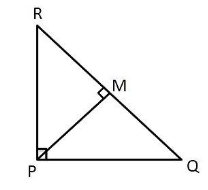
PQR is a triangle right angled at P and M is a point on QR such that PM $ \bot $ QR, Show that $P{M^2} = QM \cdot MR$
Answer
423k+ views
Hint: For the right angled triangle, we have to use Pythagoras theorem to get the desired solution.
From the given information, if we draw a triangle it is similar to the figure below.

In $\vartriangle PMR,$ by Pythagoras theorem,
${\left( {PR} \right)^2} = {\left( {PM} \right)^2} + {\left( {RM} \right)^2}$ .... (1)
In $\vartriangle PMQ,$by Pythagoras theorem,
${\left( {PQ} \right)^2} = {\left( {PM} \right)^2} + {\left( {MQ} \right)^2}$ .... (2)
In $\vartriangle PQR,$ by Pythagoras theorem,
${\left( {RQ} \right)^2} = {\left( {RP} \right)^2} + {\left( {PQ} \right)^2}$ .... (3)
$\therefore {\left( {RM + MQ} \right)^2} = {\left( {RP} \right)^2} + {\left( {PQ} \right)^2}$
$\therefore {\left( {RM + MQ} \right)^2} + 2RM \cdot MQ = {(RP)^2} + {(PQ)^2}$ .... (4)
Adding equation (1) and (2) we get,
${\left( {PR} \right)^2} + {\left( {PQ} \right)^2} = 2{\left( {PM} \right)^2} + {\left( {RM} \right)^2} + {\left( {MQ} \right)^2}$ .... (5)
From equations (4) and (5), we get
$2RM \cdot MQ = 2{\left( {PM} \right)^2}$
$\therefore {\left( {PM} \right)^2} = RM.MQ$
Hence proved.
Note:If a perpendicular is drawn from the vertex of the right angle to the hypotenuse then triangles on both sides of the perpendicular are similar to the whole triangle and to each other. If two triangles are similar, then the ratio of their corresponding sides are equal.
From the given information, if we draw a triangle it is similar to the figure below.

In $\vartriangle PMR,$ by Pythagoras theorem,
${\left( {PR} \right)^2} = {\left( {PM} \right)^2} + {\left( {RM} \right)^2}$ .... (1)
In $\vartriangle PMQ,$by Pythagoras theorem,
${\left( {PQ} \right)^2} = {\left( {PM} \right)^2} + {\left( {MQ} \right)^2}$ .... (2)
In $\vartriangle PQR,$ by Pythagoras theorem,
${\left( {RQ} \right)^2} = {\left( {RP} \right)^2} + {\left( {PQ} \right)^2}$ .... (3)
$\therefore {\left( {RM + MQ} \right)^2} = {\left( {RP} \right)^2} + {\left( {PQ} \right)^2}$
$\therefore {\left( {RM + MQ} \right)^2} + 2RM \cdot MQ = {(RP)^2} + {(PQ)^2}$ .... (4)
Adding equation (1) and (2) we get,
${\left( {PR} \right)^2} + {\left( {PQ} \right)^2} = 2{\left( {PM} \right)^2} + {\left( {RM} \right)^2} + {\left( {MQ} \right)^2}$ .... (5)
From equations (4) and (5), we get
$2RM \cdot MQ = 2{\left( {PM} \right)^2}$
$\therefore {\left( {PM} \right)^2} = RM.MQ$
Hence proved.
Note:If a perpendicular is drawn from the vertex of the right angle to the hypotenuse then triangles on both sides of the perpendicular are similar to the whole triangle and to each other. If two triangles are similar, then the ratio of their corresponding sides are equal.
Recently Updated Pages
Master Class 10 General Knowledge: Engaging Questions & Answers for Success

Master Class 10 Computer Science: Engaging Questions & Answers for Success

Master Class 10 Science: Engaging Questions & Answers for Success

Master Class 10 Social Science: Engaging Questions & Answers for Success

Master Class 10 Maths: Engaging Questions & Answers for Success

Master Class 10 English: Engaging Questions & Answers for Success

Trending doubts
A number is chosen from 1 to 20 Find the probabili-class-10-maths-CBSE

Find the area of the minor segment of a circle of radius class 10 maths CBSE

Distinguish between the reserved forests and protected class 10 biology CBSE

A boat goes 24 km upstream and 28 km downstream in class 10 maths CBSE

A gulab jamun contains sugar syrup up to about 30 of class 10 maths CBSE

Leap year has days A 365 B 366 C 367 D 368 class 10 maths CBSE




